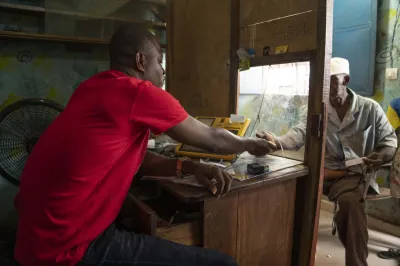Can Retail Payment Systems be Profitable and Inclusive?
Earlier this week, our colleagues from the Financial Services for the Poor team at the Bill and Melinda Gates Foundation released a comprehensive study, Fighting Poverty, Profitably, on the economics of retail payments systems – the first of its kind. At over 100 pages long (excluding appendices) there is a lot to learn and digest from the study. We think this report is an important and influential contribution. One thing we found particularly valuable is the new framework it introduces to explain the economics of payment systems. Called ACTA (Accounts, Cash-in-cash-out, Transactions and Adjacencies)1, this framework helps us think about how various providers make money in different payment systems (and with different instruments), and how relevant these approaches are for poor people.
As shown in the graph, the framework has three main business models, each illustrated with an example. The illustrations, also available in a PowerPoint deck, show whether the system or service provider is profitable or not for each aspect of ACTA.
 Figure 2 from Fighting Poverty, Profitably
Figure 2 from Fighting Poverty, Profitably
Source: Fighting Poverty, Profitably
In model 1, the providers lose money on accounts, cash-in-cash-out and transactions, but make sufficient money on the adjacencies to still be profitable. This model exists in developed countries like France and the Netherlands, where there are typically no account, cash-in-cash-out or transaction fees but where average account balances are high, and the related interest revenue from intermediating these deposits (i.e. the main adjacency income) exceeds total costs. In model 2, profits from transactions add to the profits from the adjacencies and collectively these outweigh the losses accrued from accounts and maintaining a cash-in-cash-out network. The key difference here is that clients (individuals and businesses) are charged enough for transactions to more than cover transaction-related expenses. Neither of these models is typically viable for poor clients since the related account balance-driven adjacencies are mostly insufficient to overcome system costs due to low average balances and few low-value transactions.
The study finds that “[m]odels that thrive on profitable usage of the system [such as model 3 above] have the strongest incentive to lower costs and drive volumes” which in turn benefits the poor. In this model cash-in-cash-out networks, transactions and adjacencies all generate profit and are able to collectively cover any losses associated with maintaining accounts. This is how M-Pesa in Kenya manages to be profitable, charging for cash withdrawals and transactions, and as noted below, earning significant adjacency-related income.
We find this emphasis on adjacency income - beyond interest on accounts - to serve poor clients and thus advance financial inclusion particularly useful. This includes adjacencies from the provision of broader financial services to clients, such as credit, long-term savings and insurance, as well as non-financial adjacencies such as increased foot traffic and sales for retailers or reduced churn and cost of airtime distribution for Mobile Network Operators (MNOs). The report posits that even after accounting for possible cost reductions related to improved system design, economies of scale and operational efficiency improvements, providers will still need “to generate roughly $5-to-$10 in revenue per year, per user to cover account costs, of which we believe half will need to come from revenue sources beyond interest on account balances.” The report goes further, noting that “revenues from non-financial adjacencies can be 2-to-5 times larger than financial services revenues.” Without this level of adjacency revenue providers may need to revert to (or continue charging) account fees, thus inhibiting demand.
The notion of adjacencies is well-aligned with work CGAP is undertaking, for example, related to promoting an ecosystem approach with a diverse range of providers and carving our way through all the noise around “big data” to better understand the real opportunities and business models that will drive inclusion in a responsible way. In the same way that Safaricom is able to earn significant adjacency-related income from payments (estimated in the report at $2-$6 profit per customer as a result of M-Pesa), adjacencies exist with other types of providers such as formal retail chains and aggregated independent networks of agents connected originally for selling airtime, buying in bulk, and doing bill payments or money transfers (think small mom and pop shops rather than retail chains).
This train of thought leads us into the elusive realm of successful financial inclusion partnerships structured in such a way that each partner is able to extract relevant adjacencies, with the whole mini-ecosystem ultimately exceeding the sum of its parts. A recently established Mobile Money business in South Africa called TYME is designed to benefit from such adjacencies, with the MNO (MTN) benefiting from reduced cost of airtime distribution and less churn, the retail partners (Pick n Pay and Boxer stores) benefitting from increased foot traffic and potentially lower cost of sales (if merchant payments take off), and the bank (South African Bank of Athens) realizing the float related adjacency income. It’s still early days for TYME but we like the way they are approaching things and think it can become successful.
One last thought. Adjacencies evolve over time and therefore can require a clear vision and big pockets (or an alternative revenue stream to buy time). We may well be wrong, but we doubt the inherent value of the transactional behavior data that M-Pesa would generate was fully understood when M-Pesa was launched. Clearly Safaricom, CBA and over 800,000 M-Shwari borrowing customers are now starting to realize the value of this data.
Michel Hanouch is a Financial Sector Specialist on the Technology and Business Model Innovation team at CGAP.
[1] Adjacencies are defined as “activities, both financial and non-financial, that generate non-payments revenue for payment system providers. Financial adjacencies include interest earned on balances held… [while] non-financial adjacencies include strategies to help companies acquire new customers, reduce customer attrition, cross-sell services, improve collections, or power other businesses with consumer insights.”




Comments
It is true such service
It is true such service providers have to look to adunct income to supplement its earnings.
Excellent Analysis Michel!
Excellent Analysis Michel! Very helpful in understanding the business case models and designing new initiatives. All payment service providers can use this framework to see where they stand and what needs to be done to ensure profitability. Would be good to know more about quantifying the non financial adjacencies..
Add new comment